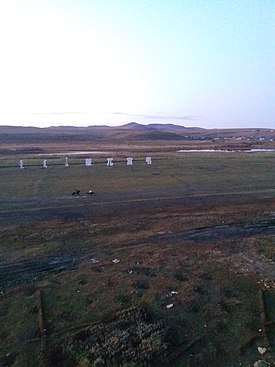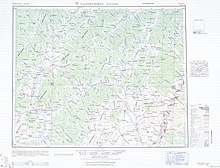Shiwei, Inner Mongolia
Shiwei (蒙兀室韦苏木) is a sumu (a type of township-level division) under the administration of Ergun City, Inner Mongolia. The township is located in Northeastern Inner Mongolia on the border with Russia.
Shiwei 蒙兀室韦苏木 | |
|---|---|
 Facing Russia across the Ergun River | |
| Coordinates: 51°20′14″N 119°53′47″E | |
| Country | People's Republic of China |
| Autonomous region | Inner Mongolia |
| Prefecture-level city | Hulunbuir |
| County-level city | Ergun City |
The township is one of the border crossings between China and Russia, lying on one side of the Ergune River.[1] On the opposite bank lies the Russian village of Olachi, connected to Shiwei by the Friendship Bridge.
Demographics

Shiwei is notable for being home to descendants of ethnic Russians, one of China's smallest minorities.[1] (Russians are among the 56 nationalities officially recognized in China.) Ethnic Russians first arrived in large numbers in Manchuria during the 1890s as colonists.[2] Marriages between Russian women and Han Chinese men in the towns and villages of the frontier areas along the Ergun River like Shiwei emerged in the 1890s, at the same time of the first wave of Russian settlement.[2][3] Interracial marriages between Chinese women and Russian men were rare, a marriage pattern that does not fit the colonial convention of Western men marrying native women.[2]
Economy
Shiwei serves as a border crossing between China and Russia. A Friendship Bridge was built following a joint agreement between Russia and China to construct it in 2001, an outcome of the 1991 Sino-Soviet Border Agreement, a treaty on resolving most of the border disputes between the two states.[4] Social anthropologist Ed Pulford has described the Friendship Bridge, which allows no passenger traffic and primarily serves as a crossing for trucks carrying quarried stone into China, as an example of how "even the most fervent attempts to forge cross-border linkages can become almost comically ineffective" when it comes to Russian–Chinese relations.[5]
Tourism
Domestic tourists on package tours stop in Shiwei to view the Russian side from a viewing platform on the riverbank on the Chinese side of the Friendship Bridge.[5]:103 The central square of Shiwei offers nighttime entertainment in the form of neon lights, techno music, and an atmosphere of revelry.[5]
Along with neighboring Enhe, Shiwei is marketed as a tourist destination to experience a "Russian town" in China.[6] Since being listed in 2005 by CCTV as one of the "top ten most beautiful townships in China", Shiwei has seen an influx of tourists.[3] However, domestic media and tour operators have given more weight to Enhe as the place to experience a "Russian village".[6] The Global Times in 2019 referred to Enhe as "the only Russian ethnic minority town in the country".[7]
References
- "Inner Mongolia: The Fairest of All". #legend. June 30, 2016.
- Entangled Histories: The Transcultural Past of Northeast China (PDF). London: Springer. 2014. pp. 47–58.
- "神秘室韦 中国唯一俄罗斯族民族乡(组图)". 乐途旅游网. July 3, 2014.
- A History of Water, Series III, Volume 2. p. 552.
- Pulford, Ed (2019). Mirrorlands: Russia, China, and Journeys in Between. Hurst Publishers. pp. 102–105. ISBN 978-1-78738-287-9.
- "Hulun Buir Grassland, Inner Mongolia & Russian Village". China Culture Center. 2016.
- Shan, Jie (May 13, 2019). "Small town in border region bears witness to China-Russia ties over past centuries". Global Times.